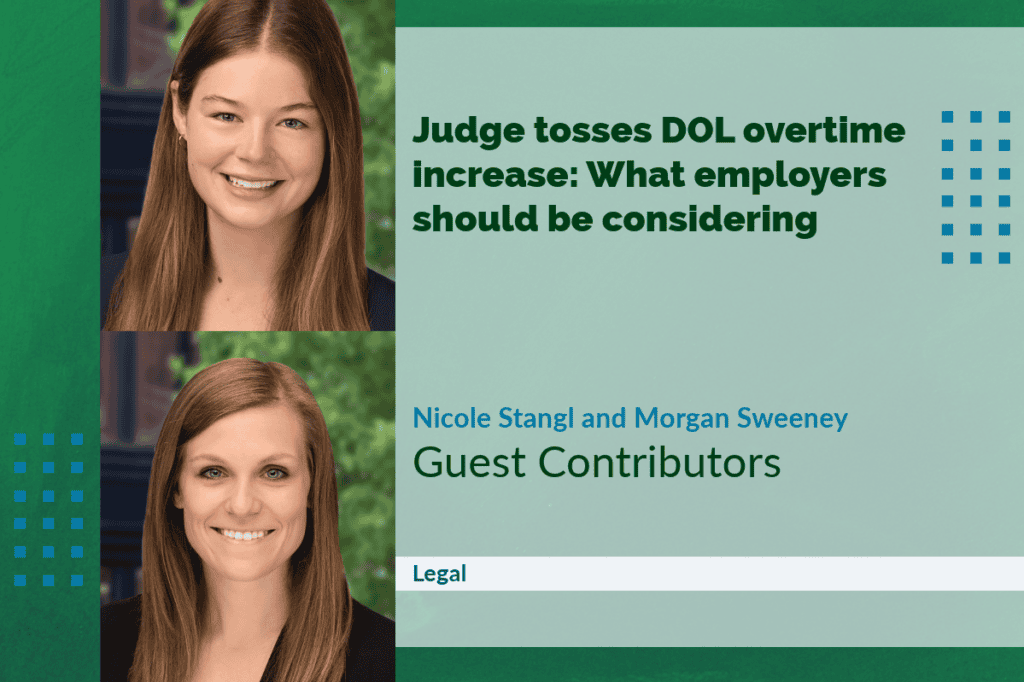
January 6, 2025
On Nov. 15, 2024, a federal judge for the U.S. District Court for the Eastern District of Texas struck down the Department of Labor’s (DOL’s) 2024 overtime rule (“Overtime Rule”).
This decision came months after the Overtime Rule went into effect and the first increase to the salary requirement was implemented.
Due to the delay in the ruling, many employers have already made changes to comply with the first increase and are left wondering what they should do now.
Background of the FLSA, EAP exemptions
The Fair Labor Standards Act (FLSA) is a federal law that requires covered employers to pay their employees at least the federal minimum wage ($7.25/hour) and overtime pay for hours worked more than 40 in a workweek.
Importantly, the FLSA includes certain categories of employees exempt from these requirements.
The exemptions relevant to the Overtime Rule are commonly referred to as the EAP exemptions: executive exemption, administrative exemption and professional exemption.
To qualify for one of the EAP exemptions, the employee must meet both the duties test and the salary basis test.
The duties test determines whether the employee’s job responsibilities qualify them for the exemption.
The salary-based test requires the employee to be paid a predetermined fixed weekly salary not subject to reduction based on the quality or quantity of work.
The weekly salary must meet the minimum level defined in the DOL’s promulgated rules.
If an employee meets both parts of the test, the employee is considered exempt, and the employer is not required to pay that employee overtime.
The Overtime Rule
The DOL issued the Overtime Rule on April 23, 2024, which increased the standard salary level for the EAP exemptions and the total annual compensation requirement for highly compensated employees (HCE).
(Note, the State of Wisconsin does not recognize the HCE exemption, so that does not apply to Wisconsin employees).
The Overtime Rule took effect July 1, 2024, and was to raise the salary level in three stages.
- On July 1, 2024, the standard salary level rose to $844 per week ($43,888 annualized).
- On Jan. 1, 2025, the standard salary level was set to increase to $1,128 per week ($58,656 annualized).
- An adopted mechanism that raises the earnings thresholds every three years.
The court’s ruling
The district court issued a vacatur, which sets aside the rule and makes it no longer binding nationwide.
The court reasoned that the Overtime Rule, “effectively eliminate(d)” the duties-based test and replaced it with a predominant focus on the salary-threshold test.
Thus, the DOL had exceeded its statutory authority under the FLSA in its implementation of the Overtime Rule.
Now what?
The vacatur of the Overtime Rule reverts the state of the law back to the pre-Overtime Rule landscape, including reversing the increase that just took effect on July 1.
The previous salary threshold of $684 per week ($35,568 annualized) will now be back in effect.
Though the DOL appealed the decision, the incoming administration may choose not to continue to pursue the appeal.
With this change, employers are now left in a lurch as many have taken various action steps toward compliance.
Employers who evaluated their pay practices and changed employees to hourly non-exempt employees based on the wage increase may consider reclassifying the employee back to a salaried exempt role.
However, employers should be mindful of the impact on morale and job satisfaction of the employees who may feel like they are getting the short end of the stick by no longer receiving overtime.
Employers should also be mindful that the quick change back and forth may leave employees confused and frustrated.
Similarly, though legally permissible, it will likely be hard to justify a pay decrease back to pre-Overtime Rule thresholds for employees who experienced a bump in their pay.
Employers may want to evaluate other ways to help offset the costs to the employer without decreasing an employee’s wages based on the vacatur of the Overtime Rule.
With that said, even employers who took no action under the Overtime Rule may want to evaluate its impact on their workplace.
If other employers in the same industry increased wages to meet the new threshold under the Overtime Rule, not adjusting wages in one’s workplace could put them at a competitive disadvantage.
Other wage, hour traps
Though the injunction of the Overtime Rule may have some employers relieved that their employees’ salary changes and reclassifications no longer need to be implemented, it should serve as a reminder of other important wage and hour compliance hot topics.
Overtime Rate: Under the FLSA an employee’s overtime rate of pay is one and one-half the regular rate of pay.
The regular rate is defined to include all compensation for employment paid to the employee by the employer.
The regular rate calculation for a work week is Total Compensation/Total Hours Worked.
The total compensation calculation must include anything given to the employee that is of value unless it fits within the identified exclusions in the statute.
Misclassification: It is important to ensure employees not only properly meet exemptions from overtime (as discussed above) when determining whether an employee is exempt or non-exempt.
Equally important is the determination of whether a worker is an employee or an independent contractor.
Timeclock issues: Employers must ensure they have a system in place for employees to track and record all hours worked.
Time-tracking systems can be a helpful tool, but they can easily open employers up to risk.
Make sure to regularly audit your practices related to time clock rounding and break times to ensure compliance with the ever-changing legal landscape.
Employers should make sure to regularly evaluate their wage and hour practices to ensure compliance.
 It’s a touchdown for Paper Valley’s Tyson Siebers
It’s a touchdown for Paper Valley’s Tyson Siebers Just dropping by: Odyssey Climbing + Fitness in Ashwaubenon
Just dropping by: Odyssey Climbing + Fitness in Ashwaubenon




